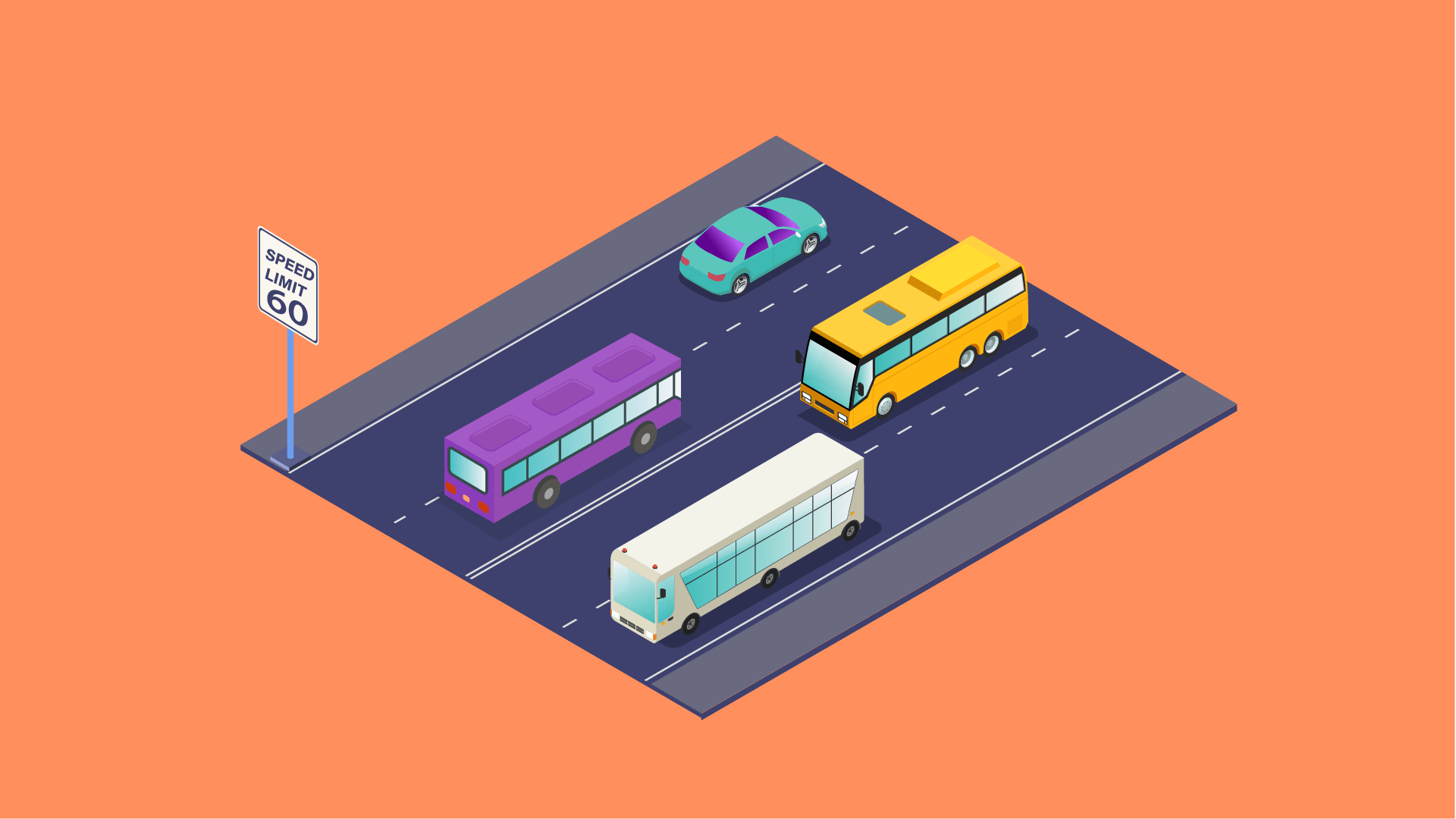Speed limit on dual carriageway for buses and coaches
The national speed limit for buses and coaches on a dual carriageway is 60 mph. Avoid relying on the limiter while driving on dual carriageways. Show consideration for faster-moving traffic by refraining from using the middle or outside lanes unless it's necessary.

Contents
- What's the National Speed Limit?
- National Speed Limit for Buses and Coaches on Dual Carriageways
- Types of Speed Limits
- Importance of Sticking to Speed Limits
- Practical Tips for Drivers Operating Buses and Coaches
- That’s A Wrap!
- FAQ
Driving on dual carriageways can be an exhilarating experience. Understanding speed limits on a dual carriageway for various vehicles is crucial. It ensures safety and compliance with traffic regulations. In this guide, we'll specifically focus on what's the national speed limit for buses and coaches on dual carriageways.
What's the National Speed Limit?
As a new driver hitting the roads, know that speed limits vary. They depend on the type of vehicle and the road. Dual carriageways, with their divided lanes, present a unique set of rules for buses and coaches.
National Speed Limit for Buses and Coaches on Dual Carriageways
The national speed limit for buses and coaches on dual carriageways is 60 mph. This limit is in place to balance efficient traffic flow while maintaining safety standards. Understanding this limit is crucial. It's not only for legal compliance but also for the safety of everyone on the road.
Types of Speed Limits
1. Basic Speed Limits
Basic speed limits are fundamental regulations set for different types of roads. These serve as general guidelines, providing a maximum permissible speed for vehicles. In urban areas, the limit typically stands at 30 mph, while rural roads may vary between 50 mph and 60 mph.
2. Variable Speed Limits
Variable speed limits are dynamic. They adjust based on real-time traffic conditions. Commonly found on highways, these limits are displayed on electronic signs. They help manage traffic flow efficiently, responding to factors like congestion, accidents, or adverse weather.
3. Advisory Speed Limits
Advisory speed limits are recommendations rather than strict regulations. These suggest a safe and appropriate speed for specific road conditions, such as sharp curves or intersections. While not legally binding, adhering to advisory limits enhances safety.
4. Minimum Speed Limits
Minimum speed limits ensure that vehicles maintain a reasonable pace on certain roads. These roads include highways and expressways. These limits prevent slow-moving vehicles from impeding the flow of traffic.
5. School Zone Speed Limits
School zones have reduced speed limits during specified times to enhance the safety of children. Typically set at 20 mph, these limits aim to protect young pedestrians. They ensure a cautious approach in areas with heightened child activity.
6. Work Zone Speed Limits
Work zones, marked by construction activities, have specific speed limits. These limits safeguard both drivers and construction workers. These limits are crucial for navigating altered road conditions and potential hazards within construction zones.
7. Special Speed Limits
Special speed limits cater to specific circumstances, such as speed limits for trucks or buses. These tailored limits recognize the unique characteristics of certain vehicles. It ensures safe and controlled operation on the road.
8. Absolute Speed Limits
Absolute speed limits are fixed maximum speeds applicable under all conditions. These are the conventional speed limits found on most roads. It offers a clear standard for drivers to follow regardless of external factors.
| Vehicle Type | Dual Carriageway | Single Carriageway | Built-Up Area |
| Cars & Motorcycles | 70 mph/112 km/h | 60 mph/96 km/h | 30 mph/48 km/h (England, Scotland & Northern Ireland); 20 mph/32 km/h (Wales) |
| Buses & Coaches | 60 mph/96 km/h | 60 mph/96 km/h | 30 mph/48 km/h (England, Scotland & Northern Ireland); 20 mph/32 km/h (Wales) |
This chart offers new drivers a quick reference. It highlights the specific speed limit for buses and coaches on dual carriageways.
Importance of Sticking to Speed Limits
Adhering to speed limits is not just a legal obligation. It's a fundamental aspect of responsible driving. Driving at appropriate speeds enhances overall road safety. It also reduces the risk of accidents, and ensures a smoother flow of traffic.
Practical Tips for Drivers Operating Buses and Coaches
For bus and coach drivers on dual carriageways, here are practical tips to remember.
Maintain a Constant Speed
Avoid unnecessary acceleration and deceleration. It promotes a steady and predictable flow of traffic.
Be Aware of Lane Discipline
Dual carriageways often have multiple lanes. Ensure you are in the correct lane and use indicators when changing lanes.
Stay Alert to Road Signs
Pay attention to speed limit signs. Also, be vigilant about road warnings and any additional instructions posted along the route.
Remember
- Anticipate traffic flow to avoid abrupt stops.
- Use indicators for timely lane changes.
- Keep a safe following distance for quick reactions.
- Check mirrors frequently for 360° awareness.
- Smooth acceleration prevents jerky movements.
- Brake gently to avoid sudden stops.
- Adapt speed to road conditions for control.
- Navigate curves smoothly by reducing speed.
- Stay vigilant for road signs and warnings.
That’s A Wrap!
Understanding the national speed limit on dual carriageways for busses and coaches is crucial. It is an essential aspect of responsible driving for drivers. Adhering to these limits and adopting safe driving practices is key. It contributes to a safer road environment for everyone.
FAQ
1. What's the national speed limit for buses and coaches on dual carriageways?
The national speed limit for buses and coaches on dual carriageways is 60 mph.
2. How do variable speed limits work on highways?
Variable speed limits adjust based on real-time traffic conditions. They are displayed on electronic signs to manage traffic flow efficiently.
3. Are advisory speed limits legally binding?
Advisory speed limits are recommendations, not legally binding. However, adhering to them enhances safety.
4. What's the purpose of minimum speed limits on certain roads?
Minimum speed limits serve to ensure vehicles maintain a reasonable pace. They prevent slow-moving vehicles from impeding traffic flow.
5. Why do school zones have reduced speed limits?
School zones implement reduced speed limits, often set at 20 mph. This is to enhance the safety of children. Also, to encourage a cautious approach in areas with heightened child activity.


